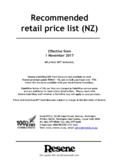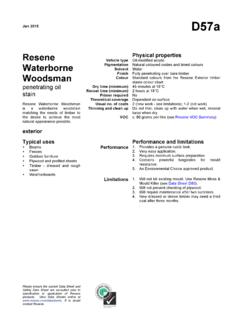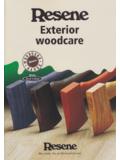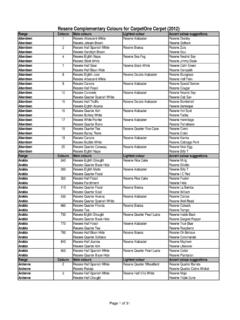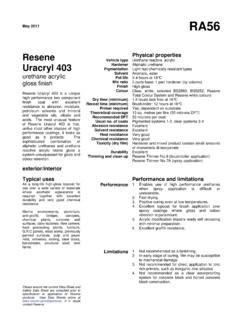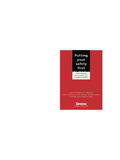Transcription of Resene Aquapoxy for Flooring - waterborne epoxy …
1 Jun 2013 RA43 Resene Aquapoxy for Flooring waterborne epoxy Resene Aquapoxy for Flooring is a two pack low VOC waterborne epoxy floor coating. The cured film is glossy and non-yellowing with high surface hardness. It has excellent adhesion and water resistance and is tolerant of application over damp surfaces. The chemical resistance is similar to conventional solventborne epoxies. Resene Aquapoxy for Flooring may be modified with Resene SRG Grit for a non-skid surface, but this will reduce cleanability. An excellent compromise consists of one coat of Resene SRG Grit modified Resene Aquapoxy then one coat of unmodified Resene Aquapoxy .
2 Vehicle type Hardener Pigmentation Solvent Pot life Finish Colour Volume Solids Dry time (minimum) Recoat time (minimum) Primer required Recommended DFT Usual no. of coats Abrasion resistance Chemical resistance Solvent resistance Durability Slip resistance Thinning and clean up Pack size VOC (mixed) Physical properties Two component epoxy epoxy resin Titanium dioxide + silica sand (optional) Water 3 hours at 21 C; 6 hours at 10 C Gloss/semi-gloss White and a limited range of chemically resistant pastel colours 43% (mixed) Semi-gloss tack free: 1 hour at 21 C; 3 hours at 10 C Gloss tack free: 3 hours at 21 C; 5 hours at 10 C Minimum: 4 hours at 21 C; 6 hours at 10 C Maximum: 5 days Yes- over steel 130 microns (total) 3 (brush/roller) Excellent Alkalis - excellent.
3 Acids - fair (when fully cured) Excellent (when fully cured) Excellent (see limitations) Slip resistance tested in accordance with AS/NZS 4586:2004. Contact manufacturer for details. Water 1, 4 and 10 litre units (10L MTO only) 66 grams per litre (see Resene VOC Summary) Interior Performance and limitations Typical uses Bitumen floors to upgrade solvent resistance Dairy units and piggeries Food processing plants Garage floors Meat works Surfaces that require regular high pressure cleaning Upgrade over sound existing paint for improved protection Performance 1. Brushing and rolling properties similar to single pack waterborne paints. 2. Tolerant of application over damp surfaces.
4 3. Quick tack free and recoat times giving the potential for multiple coats to be applied in a single day. 4. High surface hardness with excellent resistance to abrasion. 5. Can be steam cleaned or power washed. 6. Excellent resistance to chemicals, solvents and water (see Chemical resistance). 7. When used as a garage floor coating allow five days cure with good ventilation before driving onto the surface. Please ensure the current Data Sheet and Safety Data Sheet are consulted prior to specification or application of product. If in doubt contact Resene . Limitations 1. Application not recommended at temperatures below 10 C or above a of 85%.
5 Film formation/curing and adhesion may be affected if the coating is applied and cured outside of these conditions. 2. Recommended for interior use only, like all epoxies, will chalk on direct exposure to the UV. 3. Will discolour when exposed to hypochlorite (bleach containing) solutions. 4. DO NOT APPLY MIXED PRODUCT BEYOND STATED POT LIFE FOR A GIVEN TEMPERATURE. Please ensure the current Data Sheet is consulted prior to specification or application of Resene products. If the surface you propose to coat is not referred to by this Data Sheet, please contact Resene for clarification. In Australia PO Box 924, Beenleigh, Qld 4207 Call 1800 738 383, visit or email In New Zealand PO Box 38242, Wellington Mail Centre, Lower Hutt 5045 Call 0800 Resene (737 363), visit or email Printed on environmentally responsible paper, which complies with the requirements of environmental management systems EMAS and ISO14001.
6 Please recycle. Aquapoxy for Flooring waterborne epoxy Surface preparation Concrete If oil or grease are present degrease according to SSPC SP1 solvent cleaning. Leave new concrete to cure for a minimum of 28 days before painting. The plastic sheet method (ASTM D4263) should be used to check concrete floors for moisture content prior to painting. Tape a segment of clear plastic sheet ( mm thick) to the concrete floor using duct tape, making sure all edges are sealed. Allow the plastic sheet to remain in place for at least 16 hours and after the allowed time examine the underside of the sheet for the presence of moisture. If any water has condensed on the underside of the plastic sheet then application of Resene Aquapoxy for Flooring is not recommended.
7 At least one test is required for each 50 square metres of floor area. While the plastic sheet method is not a quantitative measure of moisture content of the floor, it is a suitable test to make a decision on whether painting can be undertaken. Concrete floors must be profiled by captive blasting, abrasive blasting, diamond grinding, or acid etching (see Data Sheet D83). Profiling should produce a uniform surface texture resembling 180 grit sandpaper. If this is not achieved, repeat the profiling method until the required surface texture is achieved. Concrete surfaces cured with curing compounds or contaminated with form oils must be completely cleaned by abrasive blasting (acid etching is not acceptable as this procedure will not normally remove these compounds).
8 After blasting or etching fill holes, voids, etc by application of Resene Epox-O-Bond epoxy Filler (see Data Sheet D808). Residues and dust from old paint systems containing lead or chromate may be dangerous to the health of the operator and the environment. Ensure approved procedures are put in place to safeguard against this. Application Application standard Apply by brush or PAL Hi- Solids roller. Spray application can be used for Flooring applications. The product can be spray applied to vertical surfaces but the recommended dry film thickness cannot be achieved wet on wet. Application - SRG Grit modified Apply by roller. First coat - Unmodified Resene Aquapoxy for Flooring (spreading rate of 10 square metres per litre).
9 Second coat - Resene Aquapoxy for Flooring modified with Resene SRG Grit added at 2kg per 4 litre mix (spreading rate of square metres per litre). Third coat - Unmodified Resene Aquapoxy for Flooring (spreading rate of 10 square metres per litre). Mixing Resene Aquapoxy is supplied as a base and a hardener. TO ENSURE THE CORRECT MIX RATIOS ARE ACHIEVED MIX FULL UNITS. To one part by volume of base add one part by volume of hardener. Mix these thoroughly either by hand or by power tool until they are perfectly homogeneous. Mixed product will remain liquid well past pot life. DO NOT APPLY MIXED PRODUCT BEYOND STATED POT LIFE AT A GIVEN TEMPERATURE.
10 Resene SRG Grit is added at the completion of the mix, 2kg into the 4 litre mixture. Mix in a separate container of sufficient size to hold approximately 5 litres. Ensure painted areas are well ventilated post application. Forced air or extraction systems are recommended. DO NOT USE gas or fuel burning heaters if heating is to be used as the fuel combustion process adds to the humidity in the atmosphere. Safety precautions Consult Safety Data Sheet for this product prior to use. Users should ensure that they are familiar with all aspects concerning safe application of this product. IF IN DOUBT, DO NOT USE THIS PRODUCT.
